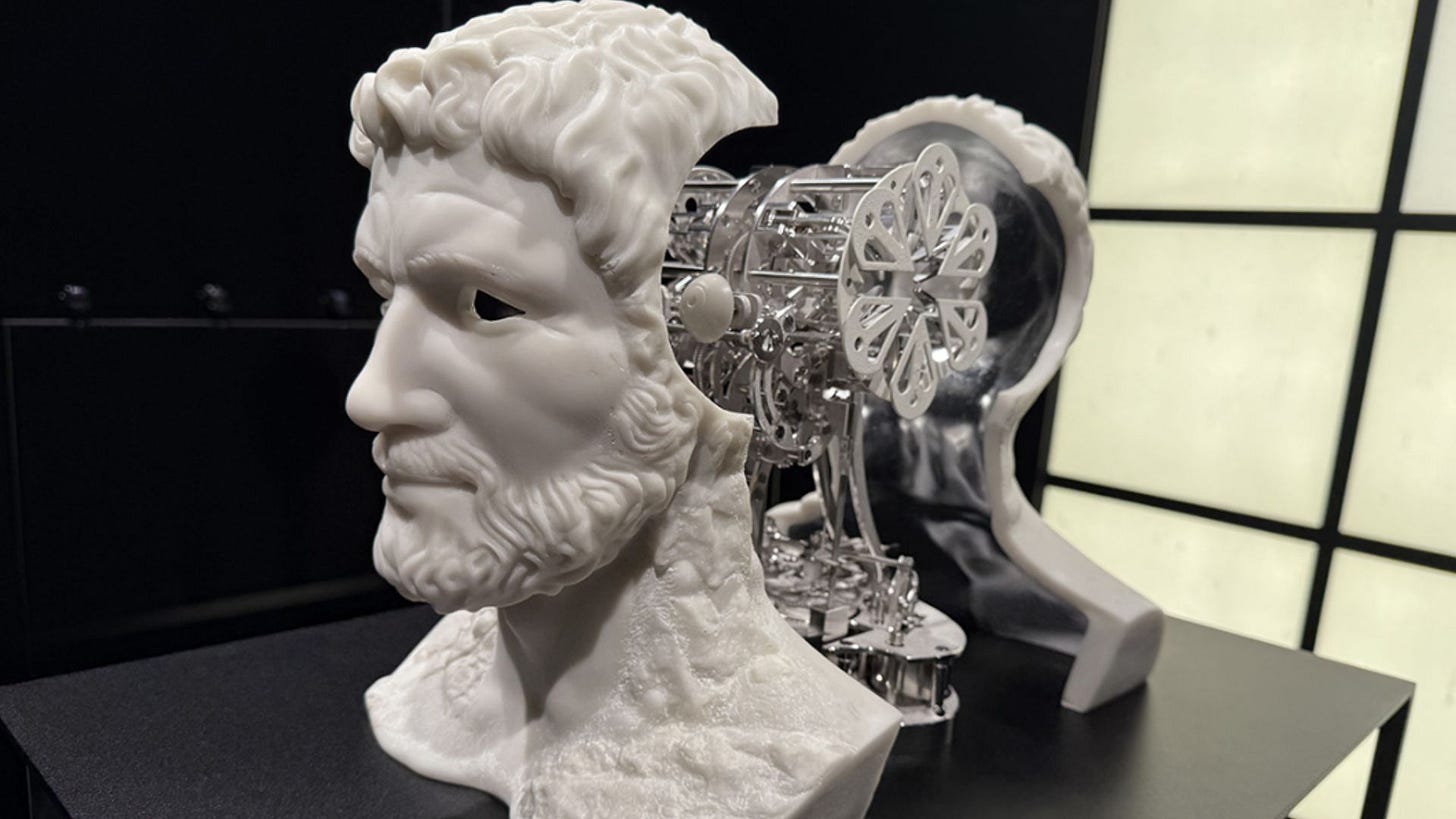Hublot’s Big Bang Turns 20, Breguet Champions Guilloché, and Moser Gets Sunny-Side Up.
This week on WorldTempus: Hublot’s iconic Big Bang collection celebrates its birthday, Breguet masters the art of guilloché, Moser releases a bold watch, Breitling collaborates with the cycling world.
THIS WEEK’S NEWS
Hublot Celebrates 20 Years of Innovation with a Bold New Big Bang Chapter
In marking the 20th anniversary of the Big Bang collection, Hublot is not simply celebrating a milestone—it is initiating a bold new era. At the helm of this evolution is CEO Julien Tornare, who offers a compelling look into the journey that transformed the Big Bang from a disruptive newcomer into a symbol of modern horology.
Since its launch in 2005, the Big Bang has been a cornerstone of Hublot’s philosophy, challenging conventions through its daring design and innovative materials. This year’s commemorative models continue that legacy with a vibrant palette and advanced construction, reaffirming the brand’s commitment to what it calls the Art of Fusion.
Tornare emphasizes how the latest iterations integrate modern design language with cutting-edge technological developments. These new watches stand out not only for their vivid color schemes but also for their use of state-of-the-art materials, echoing two decades of relentless experimentation and creativity.
What makes this anniversary particularly noteworthy is how seamlessly the new Big Bang pieces bridge heritage and innovation. The watches are unmistakably contemporary while staying true to the disruptive spirit that defined the original model. Each component reflects Hublot’s ongoing exploration of new textures, tones, and techniques—pushing the limits of material science in watchmaking.
As Hublot continues to evolve, its approach remains rooted in fusion: blending unexpected materials, combining traditional craftsmanship with forward-thinking innovation, and challenging perceptions of what a luxury timepiece can be. The Big Bang, now 20 years strong, does not rest on its legacy. Instead, it reaffirms its role as a dynamic, ever-evolving icon in contemporary watchmaking.
Understanding Guilloché with Breguet
Far from being a mere decorative flourish, guilloché began as a functional technique. Its finely patterned surfaces reduced glare for watchmakers, improved legibility, and even minimized corrosion risk. Abraham-Louis Breguet quickly recognized its full potential, elevating it into an art form that blended utility with refinement. Today, Breguet remains one of the rare maisons that continues to preserve and evolve this centuries-old craft.
However, traditional guilloché faces increasing pressure. Widespread adoption of CNC machinery and advanced technologies like FEMTO laser engraving has led to an abundance of mechanical imitations. Yet the authenticity and character of hand-operated guilloché remain unmatched. The craft’s decline stems from three converging challenges: a scarcity of trained artisans, the lengthy training process, and the rarity of the machines themselves. Becoming a fully skilled guillocheur requires at least three years of apprenticeship, and suitable equipment—often more than a century old—is increasingly difficult to acquire.
Breguet stands almost alone in its enduring commitment to this delicate technique. As early as 1786, the watchmaker integrated multiple guilloché motifs into a single dial, as seen in the perpetual repeater watch No. 46 from 1787. This zoned dial design, featuring different patterns for different sections, continues today in references like the Classique Chronométrie 7727.
The brand’s artisans master a rich vocabulary of motifs, from the classic Clou de Paris and Grain d’Orge to more contemporary designs. The Marine Tourbillon Équation Marchante 5887, for instance, introduces a wave motif reflecting its nautical inspiration. Breguet’s archives also preserve lesser-known patterns, such as the granulated motif on watch No. 92 or the two-tone guilloché of the Art Deco period—styles that, though dormant, could inspire future creations.
As Breguet celebrates its 250th anniversary, the brand’s stewardship of guilloché remains a powerful reminder of horology’s artistic roots and its potential for continual reinvention.
NEW WATCHES
Breitling Honors Cycling Legends with Top Time Coppi and Bartali Editions
Breitling revisits a defining era in cycling history with the release of two limited-edition Top Time chronographs, paying tribute to Italian icons Fausto Coppi and Gino Bartali. More than rivals, Coppi and Bartali were national heroes whose mutual respect and enduring friendship became symbols of resilience during a challenging post-war period. Their legacy now lives on through these timepieces, which capture both their personalities and their impact on sport and culture.
The Top Time collection, originally introduced in the 1960s, was Breitling’s answer to the demand for bold, stylish chronographs suited for a younger, speed-focused audience. These new editions retain that spirit while introducing visual elements directly tied to the cyclists' stories. The Fausto Coppi model features turquoise subdials against a white backdrop, with an orange lightning bolt seconds hand reflecting the colors of Coppi’s bicycle. The Gino Bartali version offers a deep blue dial with yellow details, a nod to his memorable jersey.
Each of the 750 examples bears a personalized tachymeter scale—“Il Campionissimo” for Coppi and “L’Intramontabile” for Bartali—along with their engraved signatures at six o’clock. The subdials include fine brushed textures, symbolizing the parallel paths of two champions who competed side by side. The 41 mm cases house the in-house Manufacture Caliber 01, delivering COSC-certified precision, an approximate 70-hour power reserve, and a transparent caseback engraved with the tribute message and series number.
Buyers can choose between a perforated leather strap or stainless-steel mesh bracelet, enhancing the models’ retro-modern aesthetic. As CEO Georges Kern noted, “Coppi and Bartali had one of the greatest rivalries in sports. They pushed each other to new heights.”
These commemorative pieces celebrate not just horology, but a timeless story of determination, unity, and excellence through adversity.
When Time Hatches Brilliance
With a theatrical flair and philosophical wit, H. Moser & Cie. introduces a timepiece that breaks the mold—quite literally. The Pioneer Centre Seconds Sunny-Side Up does not simply tell time; it commands attention. In a surreal narrative that pairs metaphysics with brunch, the brand offers a watch that emerges as both a visual spectacle and a commentary on timelessness itself.
At the heart of this creation is a dial the color of golden yolk, bold and unfiltered. Its sunshine yellow hue evokes both playfulness and audacity, standing apart from traditional palettes while radiating clarity and joy. The vibrant surface is polished to a glossy perfection that catches light from every angle, framed by the robust Pioneer case, known for its sportier aesthetic and water resistance.
Moser transforms this unconventional watch into a stage for philosophical performance. It is described as a character in its own right—“Your Egg-sistential Highness”—mocking the eternal debate of chicken versus egg. Yet behind the humor lies a serious watchmaking pedigree. The movement within, although not specified in the narrative, follows Moser’s standard of in-house mechanical excellence, known for precision and understated complexity.
Design elements such as the radiant dial and the domed sapphire crystal create a tactile depth, giving the impression that the sun has settled just beneath the watch face. The overall silhouette remains consistent with the Pioneer line, known for balancing elegance and resilience—attributes well-suited for those who dare to wear a yellow dial with confidence.
More than a watch, the Pioneer Centre Seconds Sunny-Side Up is a provocation—calling into question time’s linearity, existence itself, and the cultural sanctity of brunch. In this world of horological storytelling, Moser proves that serious watchmaking can still crack a smile.
EVENTS
GMT Watch Safari Returns for a Deeper Dive into Swiss Watchmaking
After a highly praised first edition in 2024, GMT Publishing is bringing back the Watch Safari from October 26 to November 1, 2025, offering horology enthusiasts a rare opportunity to explore the inner workings of Switzerland’s most prestigious watch Manufactures. Designed as a fully immersive, week-long journey, the experience invites 18 selected participants—half of whom have already secured their places—to discover the artistry, innovation, and heritage that define the contemporary watch industry.
Originally conceived to celebrate GMT’s 24th anniversary, the Watch Safari opens the doors to an otherwise private world. Participants will visit two different Manufactures each day, ranging from industry pillars like Breguet to storied institutions such as Minerva. More than factory tours, these visits include face-to-face meetings with brand executives and watchmakers, offering a rare and candid glimpse into the human side of high-end watchmaking.
The program is enriched each evening with a third curated activity, carefully selected to remain inaccessible without GMT’s exclusive network. These moments—private events, behind-the-scenes presentations, or unique horological encounters—deepen the connection between participants and the brands involved.
Logistics are fully managed by GMT Publishing, including accommodations in 4-star hotels, all meals, cocktail events, and local transfers, ensuring that guests can focus entirely on the experience. Accompanied by two members of the editorial team, including a videographer, participants will not only gain personal insights but also be part of a shared adventure with fellow collectors and connoisseurs.
As the second edition promises to build on the success of its debut, the Watch Safari stands as more than a watch tour—it is a cultural and educational exploration of craftsmanship at its highest level.
Watches and Wonders 2025: Four Timepieces That Redefine the Limits of Watchmaking
This year’s Watches and Wonders exhibition delivered no shortage of surprises, but four standout creations pushed boundaries with daring concepts, mechanical ingenuity, and uncompromising artistry.
Among the most startling was Le Temps Retrouvé by Trilobe, a philosophical and sensory automaton shaped as a fragmented human bust. Referencing Proust and designed by Boris Masur in Sainte-Croix, the piece displays hours on floral petals and minutes through rotating eyeballs. The automaton also breathes and releases a custom fragrance, turning each interaction into a multisensory performance. Priced at €400,000 before tax, the creation can be personalized with a mold of the collector’s own face, offering a truly unique—and unsettling—embodiment of time.
In contrast, 1816 by Louis Moinet pays tribute to historical continuity. Marking the 210th anniversary of the original “Compteur de Tierces,” this modern interpretation honors the inventor of the chronograph with remarkable fidelity. Housed in a 40.6 mm titanium case and featuring Louis Moinet’s first integrated metal bracelet, the piece contains a completely original movement composed of 330 components. It is both a historical homage and a contemporary technical achievement.
Vacheron Constantin stunned with Solaria, a watch that redefines mechanical complexity. Containing 41 complications and over 1,500 components in a 45 mm case, the timepiece manages civil, sidereal, and solar time using three gear trains. Eight years of development and 13 patent filings underscore the extraordinary ambition behind this astronomical wristwatch.
Finally, A. Lange & Söhne presented Répétition Minute Perpétuelle, a platinum-cased marvel limited to only 50 units, with production extending to 2030. Valued at approximately €750,000, the watch exemplifies discreet, ultra-exclusive craftsmanship—timeless in approach and untouched by commercial trends.
Together, these four watches represent the extremes of creativity, heritage, and complexity, reinforcing the limitless scope of contemporary horology.











